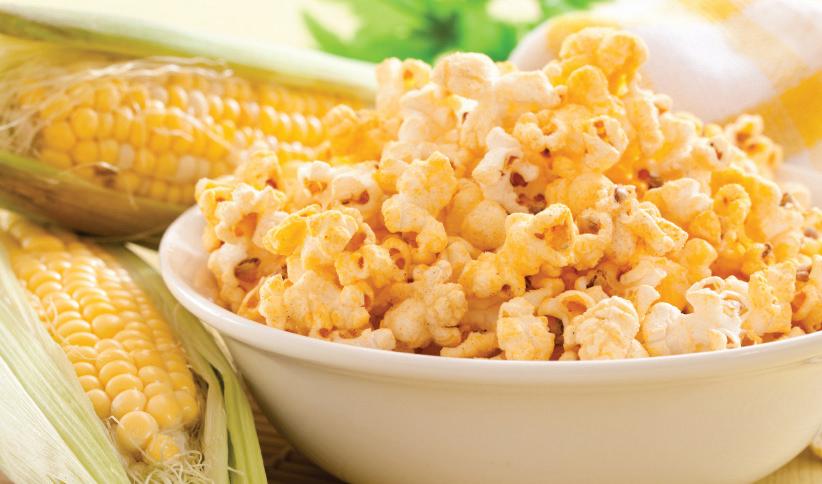
3 minute read
Popcorn
INTRODUCTION
Popcorn, a whole grain product, has been around for thousands of years. Th e oldest discovered ears of popcorn were in a bat cave west of central New Mexico in 1948, and they are more than 5,500 years old. Popcorn has also been excavated out of tombs in South America; and it was so well preserved, that it still popped. (Grain Information, 2012). During WWII popcorn was sold as a “candy” replacement for the lack of sugar in America. Today the average American will consume 49 quarts of popped corn a year (Popcorn Board, 2013).
QUALITY & PURCHASE
Popcorn is sold either as a plain or fl avor-added popped product or as an unpopped product in moisture-proof containers ranging from plastic bags and sealed jars to readyto-use containers both for conventional and microwave popping. Popcorn fl avor is enhanced to individual tastes with the addition of salt and butter (Carter, 1989).
According to the Gale Research of 1996 for encyclopedia.com, popcorn is the only corn that pops; it is not dried kernels of sweet corn. Th ere are several popular varieties of popcorn and thousands of hybrids.
White hull-less and yellow hull-less are the varieties sold most commonly and packaged in microwave bags.
Rice popcorn is a variety with kernels that are pointed at both ends.
Pearl popcorn produces round, compact kernels.
Strawberry popcorn has tiny red ears that are shaped like strawberries and produce red kernels.


Black and blue varieties of popcorn have colored grains that pop as white kernels.
Rainbow or Calico corn has white, yellow, red, and blue kernels.
STORAGE CONDITIONS & SHELF LIFE
Store popcorn the same as most grains. Keep the kernels in a cool, dry location. Choose containers that protect the popcorn from insects, rodents, and moisture. When popcorn is stored in ideal conditions, it has an indefi nite shelf life. however, for best results, store in airtight containers and use within 1 year of purchase.
NUTRITION Popcorn, a whole grain, can be a healthy snack. Popcorn contains substantial amounts of carbohydrates, fi ber, many of the B vitamins, potassium, phosphorus, magnesium, iron, zinc, pantothenic acid, copper, manganese, linoleic acid,
POPCORN POPPED NUTRITION VALUE PER 100 g (3.5 oz)
Calories 1 cup Carbohydrates Sodium Fat Protein Sugars Dietary Fiber 31 6 g 1 mg 1 g 1 g 1 mg 1 g
Percentages are relative to U.S. recommendations for adults. Nutrient data for this listing was provided by USDA SR-21. Nutrition Data. Available at: http://nutritiondata.self.com/facts/ snacks/5659/2
Popcorn can be ground into corn fl our, leaving the germ intact. Th e grinding process exposes the oils to air and they break down quickly. Only grind as much as you need for a recipe since ground popcorn does not store well (Rose, 2011).
Another use for popcorn is to make fl our out of popped kernels. To make this fl our, place popped popcorn into a blender and blend until it resembles fl our. A medium texture takes about 20 seconds, but continue blending 40 to 50 seconds for fi ne fl our. During World War II, when wheat was in short supply, people combined popcorn fl our (25 percent) and wheat fl our (75 percent) for use in their recipes.
Popcorn that pops poorly with many unpopped kernels is probably too dry and needs moisture. Start by adding one tablespoon of water to a quart of popcorn, mix well a couple of times that day, then aft er 2-3 days, try popping another sample. Continue this procedure until the popcorn pops well (Carter, 1989).









